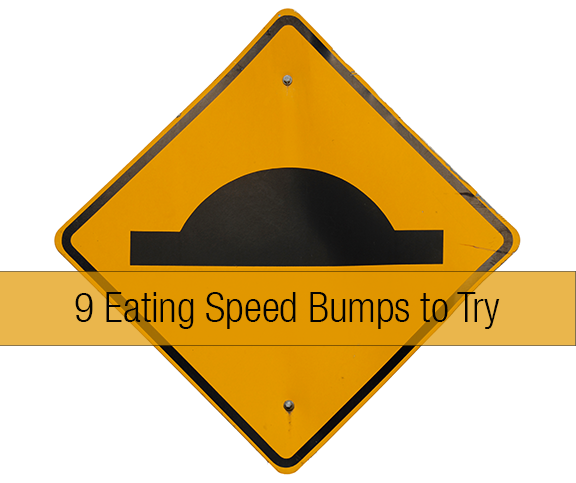One of the eating challenges we help you overcome is automatic, mindless eating. Experiment with eating speed bumps to see if they help you slow down to think as you eat.
Some of the keys to mindful eating are learning how to slow down, noticing why, what and how much you’re eating, savoring your food and the experience more, and paying attention to how your body is responding as you’re eating.
But how do you pause to remember to eat mindfully?
What is an “eating speed bump”?
 An eating speed bump is anything that interrupts an automatic, mindless behavior and reminds you to pause, think, and then respond mindfully.
An eating speed bump is anything that interrupts an automatic, mindless behavior and reminds you to pause, think, and then respond mindfully.
A good example of a speed bump from Am I Hungry? Mindful Eating programs is dividing your food in half before you begin eating.
When you “hit” this speed bump, it reminds you to slow down, pause, reassess your hunger and fullness level, and notice whether you’re really enjoying the food you chose.
With this information, you are able to decide how to proceed.
How eating interruptions help
You can think of these eating speed bumps like an external interruption. They “wake you up” as you are eating and move you out of autopilot.
Have you ever had the experience of serving yourself another portion of food then getting a phone call or some other interruption? Then when you came back to your plate, you noticed that you didn’t really want that extra serving any more?
Another good example of how an external interruption works was an experiment where an edible red potato chip was placed at regular intervals in a can of Lays’ Stackable potato chips. Researchers found that participants ate 50% fewer chips! Apparently the red chips served as a stop sign that interrupted their eating.
Eating speed bumps may be especially helpful when you’re first learning to eat mindfully. At this stage, many of your eating behaviors may be habitual and unrecognized. It takes time to remember to slow down and notice why, what, how, and how much you are eating. These speed bumps may help you break out of mindless eating and remember to eat mindfully.
Eating speed bumps are NOT portion control!
Don’t confuse these speed bumps with advice like “cut your food in half and take half home.” That type of strategy is an outside-in rule. A helpful eating speed bump just slows you down so you can make conscious decisions about your eating.
This is an important distinction because if you think of a speed bump as “portion control” that prevents you from eating more, then it will feel restrictive, just like a diet-rule. And we all know how that turns out!
Instead, become curious and experiment with speed bumps to see whether they are helpful for you.
Watch your thoughts though! Sneaky restrictive thoughts can easily slip in and cause these techniques to backfire!
Experiment with these 9 eating speed bumps
Below is a list of nine other ideas for speed bumps you can experiment with. Remember, these ideas are not intended to be used restrictively, like “portion control.” Instead, approach your experiments with curiosity.
- How does using smaller plates, bowls, and glasses affect my portion sizes?
- Do I notice a difference when I place a serving of food on a plate rather than eating it out of the container?
- What happens when I order or serve myself less?
- Does it help to keep serving dishes in the kitchen rather than on the table?
- Is it helpful to buy single servings, make my own snack size bags, or pack smaller containers?
- Do I like sharing meals?
- Is it easier to stop when I feel satisfied if I request a to-go container prior to starting my meal?
- What happens when I wait ten minutes before having seconds?
- Are there certain foods that I prefer to not keep in the house or at least keep out of sight?
What other speed bumps can you use to help you remember to pause and think as you are eating?
(Excerpt from chapter 8 of Eat What You Love, Love What You Eat for Binge Eating: A Mindful Eating Program to Heal Your Relationship with Food and Your Body.)
This article is updated from a previous version.
If you enjoyed this article, here are three more to help you:
Sensuous Eating: Make eating a multisensory experience
Listen to Your Body! Hunger Doesn’t Follow a Clock
How to Make Sense of Your Eating Issues


